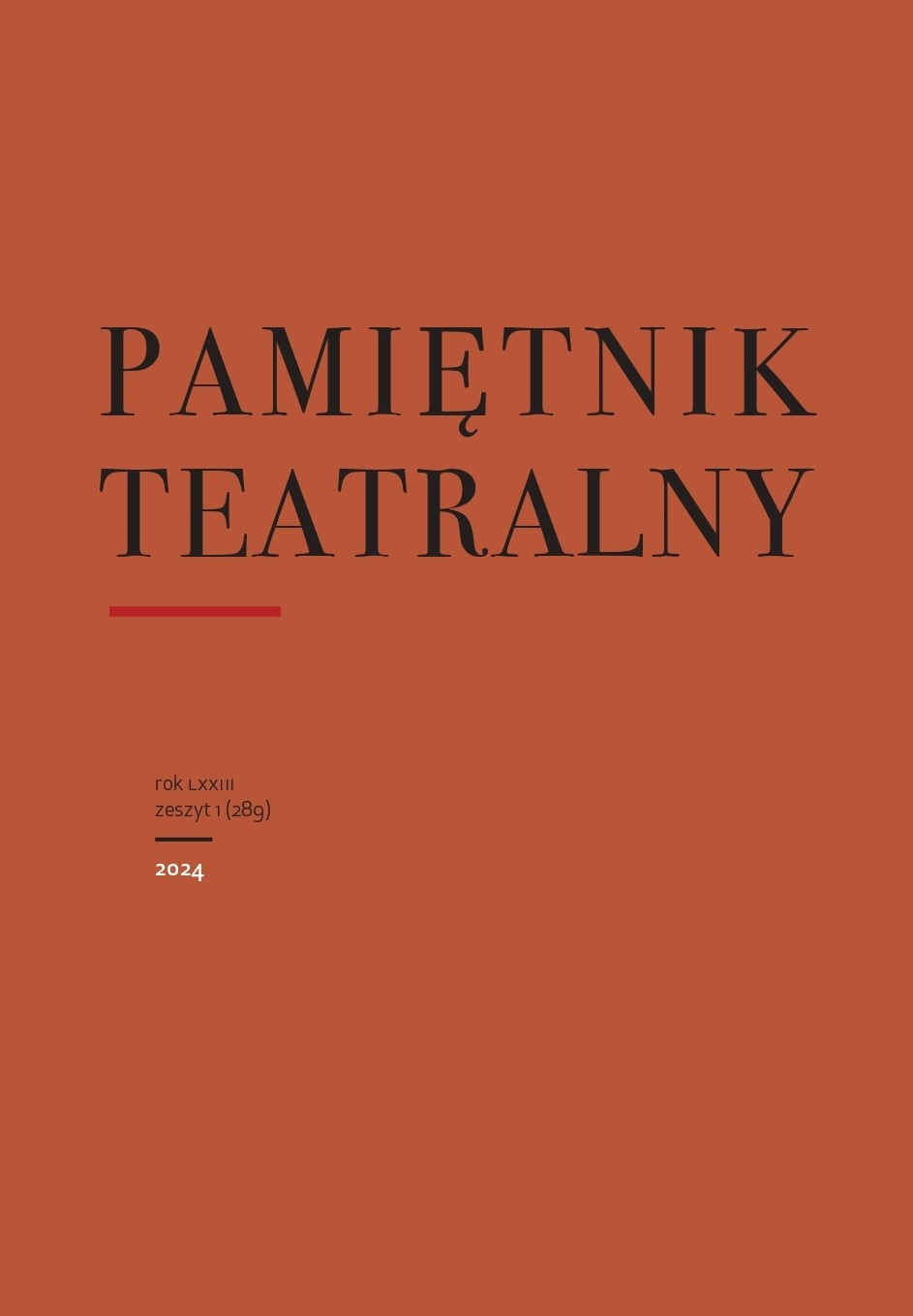Acting Near and Far
Darren Tunstall
d.tunstall@gsa.surrey.ac.ukUniversity of Surrey (Wielka Brytania)
https://orcid.org/0000-0002-8508-3321
Abstrakt
Kwestią kluczową dla powodzenia sceny dramatycznej jest ukierunkowanie uwagi aktora, ponieważ ono wpływa na punkt skupienia uwagi widzów. Autor artykułu rozpatruje zagadnienie uwagi, sięgając po teorię poziomów interpretacji (Construal Level Theory) Yacova i Libermana, w myśl której zdarzenia, również mentalne, takie jak sny i wspomnienia, są przez umysł interpretowane jako bliskie lub dalekie. Omawia znaczenie interpretacji w trybie bliskim/dalekim, przytaczając przykład swojej próby pewnej sceny ze współczesnego brytyjskiego dramatu. Dowodzi przy tym, że tryb bliski/daleki odnosi się nie tylko do zachowań niewerbalnych, lecz także do samej mowy. Jedną z podstawowych funkcji mowy jest przemieszczenie desygnatu w trybie dalekim, ułatwione przez przetwarzanie predykcyjne działania. Funkcja ta powiązana jest z teorią predykcji żalu Fritha i Metzingera. Tryb daleki jest zatem kwestią zstępującego przetwarzania semantycznego, podczas gdy wstępujące przetwarzanie sensoryczne wiąże się trybem bliskim. Przesunięcie uwagi między trybami bliskim i dalekim można zaobserwować na przykład w inscenizacjach dramatów Czechowa przygotowanych przez Stanisławskiego. Autor postuluje uznanie umiejętności skutecznego przełączania się między trybami bliskim i dalekim, zarówno w ruchu, jak i mowie, za wiarygodny wskaźnik inteligencji aktorskiej.
Słowa kluczowe:
uwaga, tryb daleki/bliski, teoria poziomów interpretacji, przemieszczenie desygnatu, teoria predykcji żaluBibliografia
Berti, Anna, and Francesca Frassinetti. “When Far Becomes Near: Remapping of Space by Tool Use.” Journal of Cognitive Neuroscience 12, no. 3 (2000): 415–420. https://doi.org/10.1162/089892900562237.
DOI: https://doi.org/10.1162/089892900562237
Google Scholar
Bickerton, Derek. More than Nature Needs: Language, Mind and Evolution. London: Harvard University Press, 2014. https://doi.org/10.4159/9780674728523.
DOI: https://doi.org/10.4159/9780674728523
Google Scholar
Butler, Isaac. The Method: How the Twentieth Century Learned to Act. New York: Bloomsbury, 2022.
Google Scholar
Clark, Andy. Surfing Uncertainty: Prediction, Action, and the Embodied Mind. Oxford: Oxford University Press, 2015. https://doi.org/10.1093/acprof:oso/9780190217013.001.0001.
DOI: https://doi.org/10.1093/acprof:oso/9780190217013.001.0001
Google Scholar
Clark, Andy, and David Chalmers. “The Extended Mind”. Analysis 58, no. 1 (1998): 7–19. https://doi.org/10.1111/1467-8284.00096.
DOI: https://doi.org/10.1111/1467-8284.00096
Google Scholar
Colby, Carol L., Jean-René Duhamel, and Michael E. Goldberg. “Ventral Intraparietal Area of the Macaque: Anatomic Location and Visual Response Properties.” Journal of Neurophysiology 69, no. 3 (1993): 902–914. https://doi.org/10.1152/jn.1993.69.3.902.
DOI: https://doi.org/10.1152/jn.1993.69.3.902
Google Scholar
Coricelli, Giorgio, Hugo D. Critchley, Mateus Joffily, John P. O’Doherty, Angela Sirigu, and Raymond J. Dolan. “Regret and Its Avoidance: A Neuroimaging Study of Choice Behavior.” Nature Neuroscience 8, no. 9 (2005): 1255–1262. https://doi.org/10.1038/nn1514.
DOI: https://doi.org/10.1038/nn1514
Google Scholar
Corlett, Philip R., Aprajita Mohanty, and Angus W. MacDonald III. “What We Think about When We Think about Predictive Processing”. Journal of Abnormal Psychology 129, no. 6 (2020): 529–533. https://doi.org/10.1037/abn0000632.
DOI: https://doi.org/10.1037/abn0000632
Google Scholar
Day, Rachel L., Kevin N. Laland, and F. John Odling-Smee. “Rethinking Adaptation: The Niche-Construction Perspective.” Perspectives in Biology and Medicine 46, no. 1 (2003): 80–95. https://doi.org/10.1353/pbm.2003.0003.
DOI: https://doi.org/10.1353/pbm.2003.0003
Google Scholar
Frith, Chris D., and Thomas Metzinger. “What’s the Use of Consciousness? How the Stab of Conscience Made Us Really Conscious.” In The Pragmatic Turn: Towards Action-Oriented Views in Cognitive Science, edited by Andreas K. Engel et al. Cambridge, MA: The MIT Press, 2016. https://doi.org/10.7551/mitpress/9780262034326.003.0012.
DOI: https://doi.org/10.7551/mitpress/10709.003.0014
Google Scholar
Gallese, Vittorio, and Michele Guerra. The Empathic Screen: Cinema and Neuroscience. Translated by Frances Anderson. Oxford: Oxford University Press, 2019. https://doi.org/10.1093/oso/9780198793533.001.0001.
DOI: https://doi.org/10.1093/oso/9780198793533.001.0001
Google Scholar
Gottlieb, Jacqueline, and Puiu Balan. “Attention as a Decision in Information Space”. Trends in Cognitive Sciences 14, no. 6 (2010): 240–248. https://doi.org/10.1016/j.tics.2010.03.001.
DOI: https://doi.org/10.1016/j.tics.2010.03.001
Google Scholar
Hall, Edward.T. The Hidden Dimension. New York: Anchor Books, 1966.
Google Scholar
Han, Nicole Xiao, and Miguel Patricio Eckstein. “Inferential Eye Movement Control While Following Dynamic Gaze.” eLife 12 (2023): e83187. Accessed September 5, 2023. https://doi.org/10.1101/2022.09.25.508620.
DOI: https://doi.org/10.7554/eLife.83187
Google Scholar
Hohwy, Jakob. “New Directions in Predictive Processing.” Mind & Language 35, no. 2 (2020): 209–223. https://doi.org/10.1111/mila.12281.
DOI: https://doi.org/10.1111/mila.12281
Google Scholar
Humphrey, Nicholas. Consciousness Regained: Chapters in the Development of Mind. Oxford: Oxford University Press, 1984.
Google Scholar
Llinás, Rodolfo R. I of the Vortex: From Neurons to Self. Cambridge, MA: The MIT Press, 2001.
DOI: https://doi.org/10.7551/mitpress/3626.001.0001
Google Scholar
Pearson, Joel. “The Human Imagination: The Cognitive Neuroscience of Visual Mental Imagery.” Nature Reviews Neuroscience 20, no. 10 (2019): 624–634. https://doi.org/10.1038/s41583-019-0202-9.
DOI: https://doi.org/10.1038/s41583-019-0202-9
Google Scholar
Stokoe, Elizabeth. Talk: The Science of Conversation. London: Robinson, 2018.
Google Scholar
Theriault, Jordan E., Liane Young, and Lisa Feldman Barrett. “The Sense of Should: A Biologically-Based Framework for Modeling Social Pressure.” Physics of Life Reviews 36 (2021): 100–136. https://doi.org/10.1016/j.plrev.2020.01.004.
DOI: https://doi.org/10.1016/j.plrev.2020.01.004
Google Scholar
Tomasello, Michael. The Cultural Origins of Human Cognition. Cambridge, MA: Harvard University Press, 1999. https://doi.org/10.2307/j.ctvjsf4jc.
DOI: https://doi.org/10.2307/j.ctvjsf4jc
Google Scholar
Tomasello, Michael, and Malinda Carpenter. “Shared Intentionality.” Developmental Science 10, no. 1 (2007): 121–125. https://doi.org/10.1111/j.1467-7687.2007.00573.x.
DOI: https://doi.org/10.1111/j.1467-7687.2007.00573.x
Google Scholar
Trope, Yaacov, and Nira Liberman. “Construal-Level Theory of Psychological Distance”. Psychological Review 117, no. 2: 440–463. https://doi.org/10.1037/a0018963.
DOI: https://doi.org/10.1037/a0018963
Google Scholar
White, Joe. Mayfly. London: Nick Hern Books, 2018.
DOI: https://doi.org/10.5040/9781784604905.00000002
Google Scholar
Autorzy
Darren Tunstalld.tunstall@gsa.surrey.ac.uk
University of Surrey Wielka Brytania
https://orcid.org/0000-0002-8508-3321
Darren Tunstall - doktoryzował się z literatury angielskiej na uniwersytecie w Cambridge i szkolił się w Bristol Old Vic Theatre School, a później u Philippe'a Gauliera, Davida Glassa i Theatre de Complicite. Pracował jako aktor, reżyser, reżyser ruchu i scenarzysta przez ponad dwadzieścia lat i był mocno zaangażowany w ruch „teatru fizycznego” w latach dziewięćdziesiątych. W 2007 roku zajął się nauczaniem w pełnym wymiarze godzin i obecnie jest profesorem nadzwyczajnym i kierownikiem programu studiów magisterskich z aktorstwa w Guildford School of Acting na Uniwersytecie Surrey w Anglii.
Statystyki
Abstract views: 167PDF downloads: 89
Licencja
Prawa autorskie (c) 2025 Darren Tunstall

Utwór dostępny jest na licencji Creative Commons Uznanie autorstwa 4.0 Międzynarodowe.
Autor/ka udziela niewyłącznej i nieodpłatnej licencji (CC BY 4.0) na wykorzystanie tekstu w "Pamiętniku Teatralnym", zachowuje nieograniczone prawa autorskie, ale zobowiązuje się do podawania miejsca pierwodruku przy ponownym wykorzystaniu artykułu (umowa licencyjna do pobrania). Zgłaszając artykuł do publikacji, autor/ka wyraża zgodę na jego udostępnianie na licencji CC BY 4.0.
Od zeszytu 1/2018 do zeszytu 3/2022 artykuły publikowane były na licencji CC BY-NC-ND 4.0. W tym okresie autorzy/ki udzielali niewyłącznej i nieodpłatnej licencji (CC BY-ND 4.0) na wykorzystanie tekstu w "Pamiętniku Teatralnym", zachowywali nieograniczone prawa autorskie, ale zobowiązywali się do podawania miejsca pierwodruku przy ponownym wykorzystaniu artykułu.









